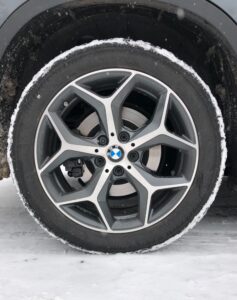Snow vs Wet Conditions: How to Pick the Best Tyres
Winter is known for posing more challenging road conditions as drivers are faced with navigating through varying weather conditions, particularly snow and wet roads. One crucial aspect of ensuring safety and optimal performance on winter roads is selecting the right tyres.
In this blog, we’ll explore the differences in the tread design and rubber compound between snow tyres and wet weather tyres, along with any advanced features, to help you make an informed decision for your vehicle this winter.
Snow Tyres
Tread Design:
Snow tyres, also known as winter or cold-weather tyres, feature a unique tread design. The tread design on these tyres typically includes deep grooves, sipes, and specialised patterns to provide better traction on snow and ice. The deep grooves help channel snow away from the tyre, preventing it from packing in and reducing traction.
Rubber Compound:
Snow tyres are made from a softer rubber compound that remains flexible in extremely cold temperatures. This flexibility allows the tyre to grip the road surface effectively, even in icy conditions. However, it’s essential to note that the softer rubber may wear out more quickly on dry or warmer surfaces.
Sipes:
Sipes are small slits or cuts in the tread of snow tyres. These help create additional biting edges, enhancing traction on snow and ice. The presence of sipes is a key feature to look for when selecting snow tyres.
A popular choice when it comes to snow tyres is the Bridgestone Blizzak LM005, a premium tyre which has a unique sipe combination that reduces stopping distance on snow and ice and an enhanced tread pattern for improved grip in snow overall.
Wet Weather Tyres
Tread Design:
Tyres designed for wet conditions focus on channelling water away from the tyre to prevent aquaplaning. They often have shallower grooves and larger contact patches to maximise grip on wet roads. The tread patterns are optimised for efficient water evacuation, making them particularly effective in heavy rain and wet roads.
Rubber Compound:
Wet weather tyres are made from a harder rubber compound compared to snow tyres. This hardness provides durability and longevity on dry and wet surfaces. However, it might compromise performance in extremely cold conditions.
Aquaplaning Resistance:
The tread design of wet weather tyres emphasises resisting aquaplaning, a phenomenon where a layer of water builds up between the tyre and the road surface, leading to loss of traction. Effective water dispersion is crucial for maintaining control in wet conditions.
A popular choice when it comes to wet weather tyres is the Goodyear Ultragrip Performance 3, a new generation winter tyre that offers enhanced, reliable grip in wet and dry weather conditions, making it a great all-rounder in winter conditions.
Choosing the Right Tyres
The best way to choose the best possible tyres for your car this winter is to consider the following two factors: your local climate and your driving habits.
Evaluate the predominant weather conditions in your region. If you frequently encounter snow and ice, opting for dedicated snow tyres during winter months is advisable. For areas with consistent wet weather, all-season or wet-weather tyres might be more suitable.
Driving habits play a large part in choosing the right tyres as you can think about the type of roads you frequent. If you often navigate through higher areas and challenging terrains where snow and ice are more predominant, investing in snow tyres can significantly enhance safety. On the other hand, if you take main routes and motorways that are gritted and heavily driven on, wet weather tyres may be a more effective choice.
Remember, investing in the right tyres is an investment in your safety on the road. At etyres, we have a dedicated range of winter tyres to enhance your safety and keep you in control this winter.




